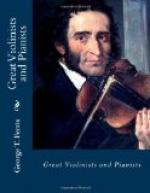During his various art wanderings through Europe, Ole Bull made many friends among the distinguished men of the world. A dominant pride of person and race, however, always preserved him from the slightest approach to servility. In 1838 he was presented to Carl Johann, king of Sweden, at Stockholm. The king had at that time a great feeling of bitterness against Norway, on account of the obstinate refusal of the people of that country to be united with Sweden under his rule. At the interview with Ole Bull the irate king let fall some sharp expressions relative to his chagrin in the matter.
“Sire,” said the artist, drawing himself up to the fullness of his magnificent height, and looking sternly at the monarch, “you forget that I have the honor to be a Norwegian.”
The king was startled by this curt rebuke, and was about to make an angry reply, but smoothed his face and answered, with a laugh:
“Well! well! I know you d—d sturdy fellows.” Carl Johann afterward bestowed on Ole Bull the order of Gustavus Vasa.
V.
Ole Bull’s first visit to America was in 1843, and the impression produced by his playing was, for manifest causes, even greater than that created in Europe. He was the first really great violinist who had ever come to this country for concert purposes, and there was none other to measure him by. There were no great traditions of players who had preceded him; there were no rivals like Spohr, Paganini, and De Beriot to provoke comparisons. In later years artists discovered that this country was a veritable El Dorado, and regarded an American tour as indispensable to the fulfillment of a well-rounded career. But, when Ole Bull began to play in America, his performances were revelations, to the masses of those that heard him, of the possibilities of the violin. The greatest enthusiasm was manifested everywhere, and, during the three years of this early visit, he gave repeated performances in every city of any note in America. The writer of this little work met Ole Bull a few years ago in Chicago, and heard the artist laughingly say that, when he first entered what was destined to be such a great city, it was little more than a vast mudhole, a good-sized village scattered over a wide space of ground, and with no building of pretension except Fort Dearborn, a stockade fortification.




